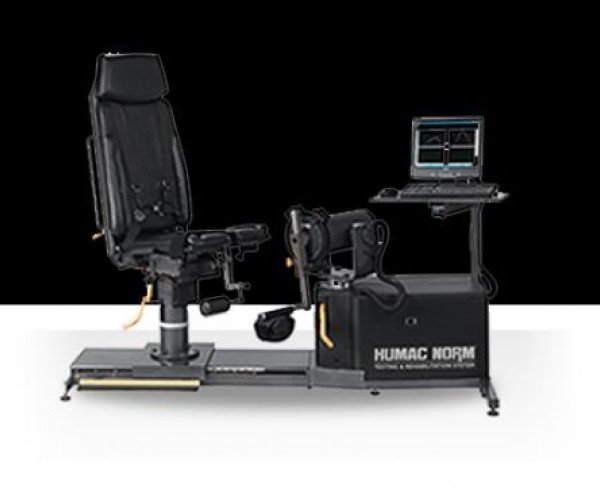


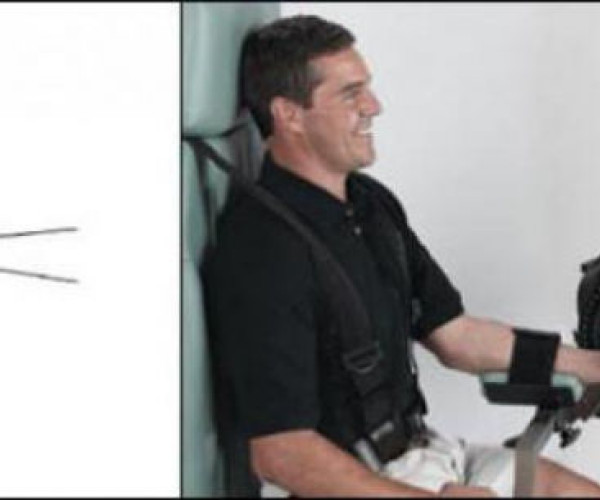
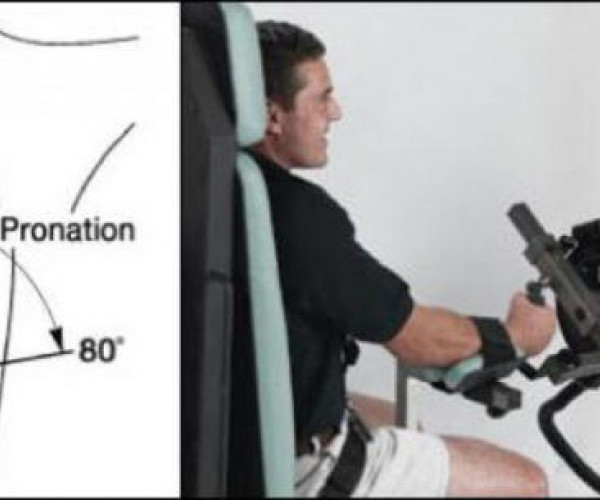

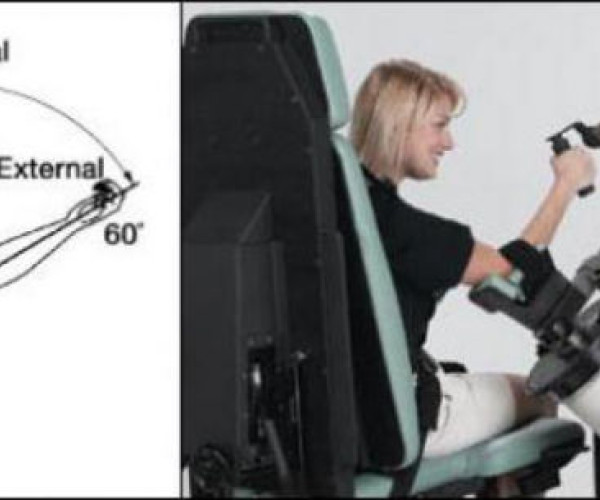
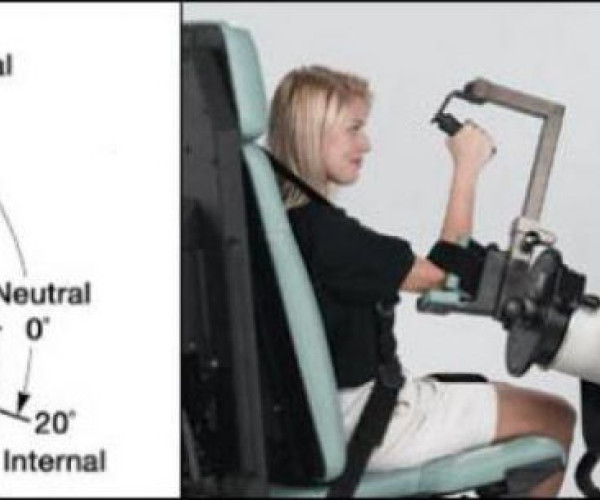
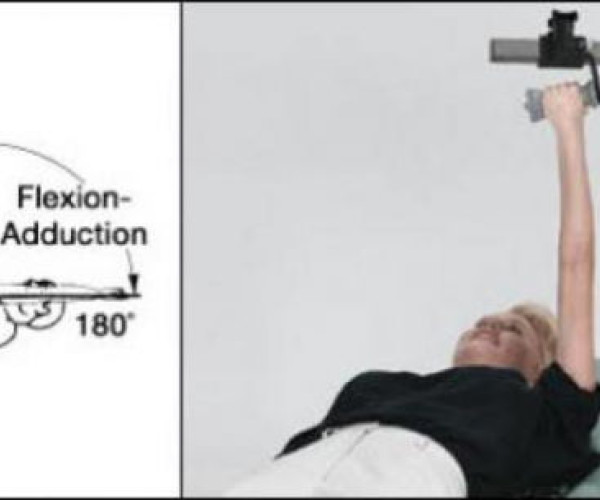


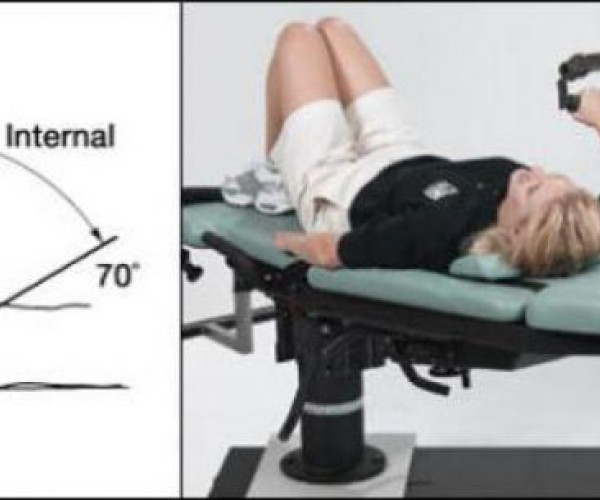












Notice:
Values are in US Dollars for direct import by the end consumer and are subject to import duties and customs duties.
(the amount can be paid in installments or financed - Find out here how to finance)
The HUMAC NORM is your solution for improving and evaluating human performance in clinics, training centers and research laboratories. In a single machine, the HUMAC NORM features 22 movement models for isolated joints, four resistance modes (isokinetic, isotonic, isometric and passive) and numerous reports in order to meet the needs of today's clinicians and researchers.
Measurement Only testing can determine guidelines, goals and changes. The HUMAC NORM offers two primary measurement solutions.
- Isometric Test:
- When dynamic movement is a concern, isometric testing is the answer.
- The HUMAC NORM will securely position the patient at every angle of the protocol.
- Protocol options include angles, work times, rest times, reps, and sets.
- Isokinetic Test:
- To determine the maximum dynamic capacity during range of motion the isokinetic test is the solution.
- The HUMAC NORM tests concentric and eccentric resistance.
- Isokinetic curve results make it easy to determine areas of pain or weakness and define capacity.
Exercise performed to improve mobility, stability, strength and control. The HUMAC NORM offers four resistance modes and numerous feedback options to achieve these goals.
- Passive Mode: Develop the mobility that the patient demands, from linear motion models to complex PNF models.
- Isometric Mode: Stabilize the joint to perform strength training at specific angles.
- Isokinetic mode: Continuous strengthening using proven methods allowing return to function including concentric and eccentric loads and deceleration training.
- Isotonic Mode: Complete return-to-function training using our isotonic mass simulated mode.
Software
- HUMAC Software was designed with one goal in mind – to allow the user to go from patient data to the report at hand as quickly as possible.
- Time is a commodity in all settings.
- This is the reason for choosing the Windows XP system for the HUMAC Software.
- It is immediately recognizable by all users, allowing you to learn and operate the HUMAC NORM quickly.
- Intuitive Steps to perform a test or exercise just select a patient, movement model, protocol and get ready to start the session.
- The next time the patient is on the HUMAC NORM the process will be even faster.
- Select Quick Test or Quick Ex to go directly from patient selection to session.
- HUMAC automatically assumes the test or exercise protocol used in the last session.
- Customize Your Preferences The Preferences settings in HUMAC give you the flexibility to customize the software to your specific needs. Preference Options include Feedback, Data Analysis and Reporting.
- Your Software will never become obsolete CSMI continues to develop the HUMAC Software.
- And we make sure that HUMAC Software is always compatible even with old equipment. From the first CYBEX II to the latest HUMAC NORM, your investment will never go out of date.
| Mode | Speeds | Torque |
| Isokinetic Concentric | 500 per sec | 500 ft-lbs / 678 Nm |
| Isokinetic Eccentric | 500 per sec | 500 ft-lbs / 678 Nm |
| CPM | 500 per sec | 500 ft-lbs / 678 Nm |
| Isometric | 500 ft-lbs / 678 Nm | |
| Isotonic | 500 ft-lbs / 678 Nm |
POWER REQUIREMENTS
| Input Voltage | 220 VAC (other voltages available) |
| Input Frequency | 60Hz (international frequency 50Hz available) |
| Independent | 20 amp dedicated circuit required |
Manufacturing
HUMAC NORM Systems are manufactured just outside Boston in Stoughton, Massachusetts, USA. The HUMAC NORM consists of four component groups – metal fabrication, computer, electronics, and software. The manufacturing process is performed under our ISO9001 Certification Process.
Metal fabrication (cut, weld, and paint) is performed by a nearby specialty custom fabrication facility. Computers are supplied by DELL Computers, the world leader in small computer systems. Custom circuit boards are designed in-house and manufactured by a nearby fabrication house. Lastly our HUMAC Software is developed and produced in-house.
The HUMAC NORM components are gathered at our corporate facility for final assembly, testing, and packaging. We ship HUMACs worldwide, with customers throughout the US, Great Britain, and elsewhere.
Regulatory Approvals
- CENELEC EN 60601-1-2 – 2001 – Medical Electrical Equipment Part 1-2: General Requirements for Safety – Collateral Standard: Electromagnetic Compatibility – Requirements and Tests IEC 60601-1-2: 2001.
- CENELEC EN 60601-1 – Medical Electrical Equipment Part 1: General Requirements for Safety Incorporates Corrigendum July 1994; Includes Amendments A1: 1993, A11: 1993, A12: 1993, A2: 1995 and A13: 1996; IEC 601-1: 1988 + A1: 1991 + A2: 1995 + Corrigendum 1995, Modified.
- UL 60601-1 – UL Standard for Safety Medical Electrical Equipment, Part 1: General Requirements for Safety First Edition.
- CSA C22.2 NO 601.1-M90 – Medical Electrical Equipment – Part 1: General Requirements for Safety General Instruction No 1; Supplement 1; 1994 R(1997).
- IEC 60601-1-1 (1992-01) – Medical Electrical Equipment Part 1: General Requirements for Safety 1. Collateral Standard: Safety Requirements for Medical Electrical Systems First Edition.
- IEC 60601-1 – Medical Electrical Equipment Part 1: General Requirements for Safety Second Edition.
CSMi Quality Certification
- ISO 9001:1994 and ISO 13485:1196 with CMDCAS.
SHOULDER: ABDUCTION / ADDUCTION
Axis of Rotation:
The instantaneous axis of rotation changes throughout the movement. The compromise axis is medial to the acromion process when the limb is in the neutral position.
Parts Needed:
- Elbow/Shoulder Adapter
- Footrest
- Lumbar Cushion
SHOULDER: EXTENSION / FLEXION
Axis of Rotation:
The instantaneous axis of rotation changes throughout the movement. The compromise axis is medial to the acromion process when the limb is in the neutral position.
Parts Needed:
- Elbow/Shoulder Adapter
- Footrest
SHOULDER: HORIZONTAL ABDUCTION / ADDUCTION
Axis of Rotation:
The instantaneous axis of rotation changes throughout the movement. The compromise axis is medial to the acromion process when the limb is in 90° horizontal abduction.
Parts Needed:
- Elbow/Shoulder Adapter
- Footrest
- Torso Belt
SHOULDER: INTERNAL / EXTERNAL ROTATION IN 90° ABDUCTION
Axis of Rotation:
The instantaneous axis of rotation changes throughout the movement. The compromise axis is medial to the acromion process when the limb is in 90° horizontal abduction.
Parts Needed:
- Elbow/Shoulder Adapter
- Footrest
- Torso Belt
SHOULDER: INTERNAL / EXTERNAL ROTATION, MOD STANDING
Axis of Rotation:
The axis of rotation is the longitudinal axis of the humerus.
Parts Needed:
- Wrist/Shoulder Adapter
- Elbow Stabilizer Pad
SHOULDER: INTERNAL / EXTERNAL ROTATION, MOD SEATED
Axis of Rotation:
The axis of rotation is the longitudinal axis of the humerus.
Parts Needed:
- Wrist/Shoulder Adapter
- Elbow Stabilizer Pad
- Lumbar Cushion
SHOULDER: INTERNAL / EXTERNAL ROTATION IN 90° FLEXION
Axis of Rotation:
The axis of rotation is the longitudinal axis of the humerus. If length adjustment of wrist / shoulder adapter is correct, and elbow flexed at 90° with forearm parallel to input arm, the axis alignment will be established and maintained by the Elbow Stabilization Pad.
Parts Needed:
- Wrist/Shoulder Adapter
- Elbow Stabilizer Pad
PNF D1: FLEXION – ADDUCTION / EXTENSION – ABDUCTION
Axis of Rotation:
The instantaneous axis of rotation changes throughout the movement. The compromise axis is medial to the acromion process when the limb is in the neutral position. The motion for this pattern begins in full Extension-Abduction and moves to full Flexion-Adduction, the limb should be supinated and externally rotated.
Parts Needed:
- Elbow/Shoulder
- Adapter Footrest
ELBOW: EXTENSION / FLEXION
Axis of Rotation:
The axis of rotation is immediately distal to the lateral epicondyle and moves only slightly anteriorly as flexion increases.
Parts Needed:
- Elbow/Shoulder Adapter
- Footrest
- Lumbar Cushion
WRIST / FOREARM: PRONATION / SUPINATION
Axis of Rotation:
The axis of rotation bisects the head of the ulna distally and the head of the radius proximally. It is established by placing the forearm directly in line with the dot on the dynamometer input tube at approximately the level of the ring finger.
Parts Needed:
- Thigh/Forearm Stabilizer Tube
- Forearm Stabilizer V-Pad
- Wrist/Shoulder Adapter
- Lumbar Cushion
- Counterbalance Weight
WRIST: EXTENSION / FLEXION
Axis of Rotation:
This axis alignment is critical and somewhat difficult in the pattern. The axis of rotation is slightly oblique passing through the wrist just distal to the tubercle of the radius and the head of the ulna (approximately where the hand meets the wrist).
Parts Needed:
- Thigh/Forearm Stabilizer Tube
- Forearm Stabilizer V-pad
- Wrist/Shoulder Adapter
- Lumbar Cushion
WRIST: RADIAL / ULNAR DEVIATION
Axis of Rotation:
The axis of rotation is located approximately at the center of the capitate bone. This is found at the middle of the wrist just distal to the axis for extension/flexion.
Parts Needed:
- Thigh/Forearm Stabilizer Tube
- Forearm Stabilizer V-pad
- Wrist/Shoulder Adapter
- Lumbar Cushion
HIP: ABDUCTION / ADDUCTION
Axis of Rotation:
The axis of rotation is superior and medial to the greater trochanter.
Parts Needed:
- Knee/Hip Adapter
- Knee/Hip Pad
HIP: FLEXION / EXTENSION
Axis of Rotation:
The axis of rotation is slightly anterior in extreme flexion as the pelvis tilts to increase range of motion. The normal movement synergy does not affect testing accuracy.
Parts Needed:
- Knee/Hip Adapter
- Knee/Hip Pad
- Footrest
HIP: INTERNAL / EXTERNAL ROTATION
Axis of Rotation:
The axis of rotation is a mechanical axis of the femur (line through centers of hip and knee joints). This can be visualized, approximated and then fine adjusted during warm up/familiarization repetitions.
Parts Needed:
- Ankle Adapter
- Footplates
- Footrest
KNEE: EXTENSION / FLEXION SEATED
Axis of Rotation:
The most accurate fixed axis for rehab or testing of the knee is a line passing transversely through the femoral condyles.
Parts Needed:
- Contralateral Limb Stabilizer
- Knee/Hip Adapter
- Knee/Hip Pad
- Lumbar Cushion
KNEE: EXTENSION / FLEXION PRONE
Axis of Rotation:
The most accurate fixed axis for rehab or testing of the knee is a line passing transversely through the femoral condyles.
Parts Needed:
- Knee/Hip Adapter
- Knee/Hip Pad
KNEE: TIBIAL INTERNAL / EXTERNAL ROTATION
Axis of Rotation:
The axis of rotation is slightly medial to the longitudinal axis of the tibia. This can be visualized, approximated and then fine adjusted during warm up/familiarization repetitions.
Parts Needed:
- Ankle Adapter
- Footplates
- Thigh Stabilizer Pad
- Thigh/Forearm Stabilizer Tube
- Footrest
ANKLE: PLANTAR / DORSIFLEXION PRONE
Axis of Rotation:
The axis of rotation passes obliquely (approximately 16° anteromedially) through the tip of the fibula (lateral malleous) and the trochlea of the talus, exiting just distal to the tip of the tibia (medial malleous).
Parts Needed:
- Ankle Adapter
- Footplates
ANKLE: PLANTAR / DORSIFLEXION SUPINE
Axis of Rotation:
The axis of rotation passes obliquely (approximately 16° anteromedially) through the tip of the fibula (lateral malleous) and the trochlea of the talus, exiting just distal to the tip of the tibia (medial malleous).
Parts Needed:
- Ankle Adapter
- Footplates
- Footrest
- Thigh Stabilizer Pad
- Thigh/Forearm Stabilizer
- Counterbalance Weight
ANKLE: INVERSION / EVERSION
Axis of Rotation:
The axis is compound and changes throughout range of motion of the talo-crural joint, talocalcaneal joint and talonavicular/ calcanecuboid or transverse tarsal joint.
Parts Needed:
- Ankle Adapter
- Footplates
- Thigh Stabilizer Pad
- Thigh/Forearm Stabilizer Tube
- Footrest
